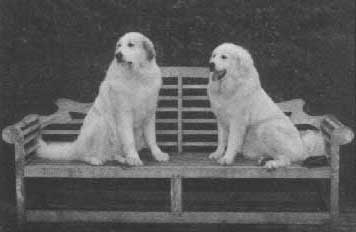(Extracts from the Hanbook of PMDC of GB - Copies available from the Secretary)
Health & Welfare
Weighing
Weighing a small puppy can be done quite conveniently by simply weighing yourself on bathroom scales with and without holding the puppy. As the puppy grows this will become impossible and even though the most accurate way is to use at the vet, if he has them, this is not always possible, so the best way is to use two sets of bathroom scales standing the dog's font legs on one and at the same time, the hind legs in the other, then simply adding the two weights together.
Taking Temperature
A healthy animal should have a considerable amount of energy. It has clear eyes and a moist nose, eats well and has solid motions. In addition, it has a normal temperature - about 101.5F (38.5C). There can be a slight variation in the normal temperature of individual dogs and it is advisable to establish what the normal temperature of your dog is. It is only by establishing this that you will be aware of any variations.
It is recommended that a clinical thermometer be kept solely for your dogs and not used for any other purpose! Make sure the mercury is below 99F (37C) in case whoever used it before forgot to shake it down. Clean thoroughly and grease the blunted silver end with vaseline then gently insert into the dog's rectum to a depth of about 1.5 inches (3.75 cms). The easiest way to perform this manoeuvre if you are on your own is to kneel on one knee by the dog's hind legs placing the other knee under the dog's abdomen. This is necessary to make sure the dog doesn't sit down. Where possible get help as the procedure is then more straightforward.
If the thermometer is more than one degree F above the dog's norm or over 103F (39.5C) regardless of the norm then IMMEDIATE veterinary help must be sought.
The word immediate cannot be stressed enough as dogs are like very small children when ill and their condition can deteriorate rapidly over a period of only an hour or so. Trying to save money by not calling the vet in these circumstances could lead to considerable unnecessary suffering on the part of the dog and its possible loss from a potentially curable condition.
Administering
Medicines
Giving a large dog pills or medicines can be quite difficult and is well worth practising when the dog is well so you know , if it ever becomes necessary. Insert your fingers into the dog's mouth by curling them over the top teeth keeping the top lip between the teeth and your fingers then gently prise the mouth open to its fullest extent flipping the pills right to the back of the throat. Now hold the mouth closed while stroking the throat to stimulate a swallowing action. Keep watch for a good minute after performing this task as quite often the pills will re-appear. All dogs are clever at concealing small pills and it is quite common to find one on the floor when you clean up the next morning! The alternative method, of concealing the pill in a titbit, is often the safest.
Administer
medicine in the side of the mouth and once again hold
the mouth shut and the head tipped back a little. With
small puppies use an eye dropper, but for adults an "eye
bath" is the correct shape to fit into mthe dog's lips
and makes administering liquid much easier.
More Questions?
If, having read all of the information
in "Think Before You Buy", you still have some more
questions you can contact any member
of the Commttee.